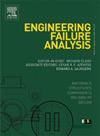Structural integrity and failure mechanisms of thermoplastic composite pipes for offshore applications: Insights from compressive and flexural testing
IF 4.4
2区 工程技术
Q1 ENGINEERING, MECHANICAL
引用次数: 0
Abstract
This research investigates the structural integrity and mechanical behaviour of a thermoplastic composite pipe (TCP) that is particularly used in the offshore energy industry. The TCP offers enhanced strength and high strength-to-weight ratio ideal for applications subject to varying loading conditions. Despite its structural benefits, the composite pipe is susceptible to delamination and other damage modes that compromise its performance. This study addresses the limited research on thermoplastic curved composite structures, especially in the context of debonding and stress distribution, by focusing on the behaviour of the TCP under compressive and flexural loading conditions. Non-destructive testing (NDT) methods, including X-ray computed tomography (XCT) and ultrasonic inspection, are employed to characterize internal damage mechanisms from these tests such as microcracking, fibre breakage, and matrix deformation at a microstructural level. Flexural testing indicates that failure initiates through tensile cracks in the outer layers, while compression testing reveals progressive damage through delamination, matrix degradation, and fibre buckling. The pipe stiffness and elastic modulus were ascertained to be 2184.2 MPa and 13.18GPa respectively. Microstructural analyses of compressive failure further reveal the complex failure pathways. This shows that matrix cracking and delamination are primary failure mechanisms driven by the polymer matrix’s limited fracture toughness and the complex stress interactions within the laminate. Delamination and matrix cracking are localized yet progressive, exacerbating the fibre to matrix separation which impact load-bearing capacity of the pipe. These findings underscore the importance of optimizing fibre orientation, matrix-fibre adhesion, and layer configuration to enhance structural toughness. This comprehensive evaluation of mechanical performance and failure mechanisms provides valuable insights for optimizing the manufacturing processes of TCP, aiming to improve durability, reduce material waste, and enhance long-term reliability in demanding service environments.
海上应用热塑性复合材料管道的结构完整性和失效机制:来自压缩和弯曲测试的见解
本研究调查了热塑性复合材料管道(TCP)的结构完整性和机械性能,该管道特别用于海上能源工业。TCP具有增强的强度和高强度重量比,非常适合各种负载条件下的应用。尽管具有结构优势,但复合管材容易发生分层和其他损坏模式,从而影响其性能。本研究通过关注TCP在压缩和弯曲加载条件下的行为,解决了热塑性弯曲复合材料结构的有限研究,特别是在脱粘和应力分布的背景下。无损检测(NDT)方法,包括x射线计算机断层扫描(XCT)和超声波检测,用于表征这些测试的内部损伤机制,如微开裂、纤维断裂和微观结构水平的基体变形。弯曲测试表明,破坏始于外层的拉伸裂纹,而压缩测试表明,破坏是通过分层、基体退化和纤维屈曲进行的。管道刚度和弹性模量分别为2184.2 MPa和13.18GPa。压缩破坏的微观结构分析进一步揭示了复杂的破坏路径。这表明基体开裂和分层是由聚合物基体有限的断裂韧性和层板内部复杂的应力相互作用驱动的主要破坏机制。分层和基体开裂是局部性的、进行性的,加剧了纤维与基体的分离,影响了管道的承载能力。这些发现强调了优化纤维取向、基质-纤维粘合和层构型以提高结构韧性的重要性。这种对机械性能和失效机制的综合评估为优化TCP的制造工艺提供了有价值的见解,旨在提高耐久性,减少材料浪费,并提高苛刻服务环境下的长期可靠性。
本文章由计算机程序翻译,如有差异,请以英文原文为准。
求助全文
约1分钟内获得全文
求助全文
来源期刊

Engineering Failure Analysis
工程技术-材料科学:表征与测试
CiteScore
7.70
自引率
20.00%
发文量
956
审稿时长
47 days
期刊介绍:
Engineering Failure Analysis publishes research papers describing the analysis of engineering failures and related studies.
Papers relating to the structure, properties and behaviour of engineering materials are encouraged, particularly those which also involve the detailed application of materials parameters to problems in engineering structures, components and design. In addition to the area of materials engineering, the interacting fields of mechanical, manufacturing, aeronautical, civil, chemical, corrosion and design engineering are considered relevant. Activity should be directed at analysing engineering failures and carrying out research to help reduce the incidences of failures and to extend the operating horizons of engineering materials.
Emphasis is placed on the mechanical properties of materials and their behaviour when influenced by structure, process and environment. Metallic, polymeric, ceramic and natural materials are all included and the application of these materials to real engineering situations should be emphasised. The use of a case-study based approach is also encouraged.
Engineering Failure Analysis provides essential reference material and critical feedback into the design process thereby contributing to the prevention of engineering failures in the future. All submissions will be subject to peer review from leading experts in the field.
 求助内容:
求助内容: 应助结果提醒方式:
应助结果提醒方式:


